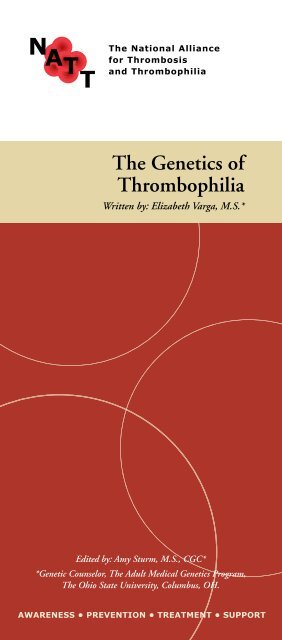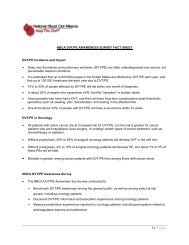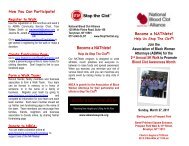The Genetics of Thrombophilia - National Blood Clot Alliance
The Genetics of Thrombophilia - National Blood Clot Alliance
The Genetics of Thrombophilia - National Blood Clot Alliance
Create successful ePaper yourself
Turn your PDF publications into a flip-book with our unique Google optimized e-Paper software.
N ATT<br />
<strong>The</strong> <strong>National</strong> <strong>Alliance</strong><br />
for Thrombosis<br />
and <strong>Thrombophilia</strong><br />
<strong>The</strong> <strong>Genetics</strong> <strong>of</strong><br />
<strong>Thrombophilia</strong><br />
Written by: Elizabeth Varga, M.S.*<br />
Edited by: Amy Sturm, M.S., CGC*<br />
*Genetic Counselor, <strong>The</strong> Adult Medical <strong>Genetics</strong> Program,<br />
<strong>The</strong> Ohio State University, Columbus, OH.<br />
AWARENESS • PREVENTION • TREATMENT • SUPPORT
<strong>Thrombophilia</strong> is a medical term used to<br />
describe the condition where the blood has an increased<br />
tendency to clot. <strong>The</strong>re are many reasons why the blood<br />
can have this increased tendency.<br />
<strong>Thrombophilia</strong> is usually categorized into two types-<br />
-acquired and inherited. In acquired thrombophilia<br />
the abnormal clotting is usually related to a specific<br />
cause, such as prolonged periods <strong>of</strong> bed rest after<br />
surgery, trauma to the leg, or having cancer. People<br />
with inherited thrombophilia tend to form clots due to<br />
a genetic predisposition inherited from their parents.<br />
People with inherited thrombophilia may have a family<br />
history <strong>of</strong> relatives with abnormal or excessive blood<br />
clotting. This brochure will explain how genes play<br />
a role in blood clotting and are related to inherited<br />
thrombophilia.<br />
BLOOD CLOTTING (COAGULATION)<br />
<strong>Blood</strong> clotting is the body’s natural defense against<br />
bleeding. A clot, or “thrombus”, develops whenever there<br />
is damage to a blood vessel (arteries and veins). <strong>Clot</strong>s are<br />
formed through a series <strong>of</strong> chemical reactions between<br />
special blood cells (platelets) and proteins in the blood<br />
(clotting factors). <strong>The</strong> platelets and factors work together<br />
to regulate the clotting process; in other words, they start<br />
and stop clotting as the body needs it. If the process does<br />
not work correctly, a clot can form in the blood vessels,<br />
blocking blood flow to the surrounding tissues. When<br />
this happens the clot is called a thrombosis.<br />
THROMBOPHILIA AND<br />
THE CLOTTING PROCESS<br />
In order for the clotting process to work, clotting factor<br />
proteins need to be present in the right amounts and<br />
work correctly. People who have inherited thrombophilia<br />
may not make the right amount <strong>of</strong> a specific clotting<br />
factor, or the factor may be abnormal in some way.<br />
<strong>The</strong>se people tend to develop a thrombosis more easily<br />
or frequently than people who do not have inherited<br />
thrombophilia.<br />
PROTEINS AND BLOOD CLOTTING<br />
Proteins are large molecules that give the body structure,<br />
help it to function, and regulate the way it works.<br />
<strong>The</strong>re are many proteins in the body and each protein<br />
has a unique function. <strong>The</strong> process <strong>of</strong> blood clotting is
an example <strong>of</strong> proteins working together. <strong>Blood</strong> cells,<br />
platelets and clotting factors are all made up <strong>of</strong> proteins.<br />
If there is a problem with these proteins, this can lead to<br />
problems with blood clotting.<br />
GENETICS, PROTEINS, AND BLOOD<br />
CLOTTING<br />
To understand how genetics influences blood clotting, it<br />
is important to understand how proteins are made:<br />
<strong>Blood</strong> clotting proteins, like all proteins, are made by<br />
linking together a chain <strong>of</strong> chemicals called amino acids.<br />
<strong>The</strong> order <strong>of</strong> the amino acids in the chain make up a<br />
specific protein; this order is determined by our genes,<br />
which are inherited by us from our parents. Genes<br />
consist <strong>of</strong> DNA, which contains our genetic code.<br />
DNA is a molecule shaped like a twisted ladder, and is<br />
made up <strong>of</strong> trillions <strong>of</strong> chemical bases. <strong>The</strong>se chemical<br />
bases are organized in sets <strong>of</strong> three and “read” by the<br />
body much like a sentence. A, T, G, and C are the<br />
“letters” <strong>of</strong> the DNA “alphabet”, or code; they stand for<br />
the chemicals adenine, thymine, guanine, and cytosine,<br />
respectively, that make up the chemical bases <strong>of</strong> DNA.<br />
Each three-letter code represents a specific amino acid.<br />
Just as your brain is able to assign meaning to words,<br />
your body is able to assign specific amino acids to each<br />
three-letter DNA code.<br />
EXAMPLES OF DNA CODING<br />
A segment <strong>of</strong> DNA code looks like this:<br />
AGCCGTACGGTTCAACCG<br />
<strong>The</strong> body reads it as:<br />
ACG-CGG-ACG-GTT-CAA-CCC<br />
Based on this, the amino acids are assigned:<br />
— — — — —<br />
Met — Arg — Thr — Val — Gln — Pro<br />
This creates a chain <strong>of</strong> amino acids that make a protein.<br />
Problems arise if there is a spelling error (mutation) in<br />
the DNA code. Mutations in the DNA code may result<br />
in an incorrect amino acid being assigned.
DNA with a mutation:<br />
ACG-CAG-ACG-GTT-CAA-CCC<br />
Causes a change in the amino acid assigned at a certain<br />
position:<br />
— — — — —<br />
Met — Gln — Thr — Val — Gln —Pro<br />
If this occurs, the protein that is being made is<br />
altered. This alteration could cause the protein to be<br />
a different shape or could cause the body to make too<br />
much protein, thus the function <strong>of</strong> the protein will be<br />
different.<br />
INHERITED THROMBOPHILIA<br />
Inherited thrombophilia occurs when an inherited DNA<br />
mutation results in the body producing<br />
a) too much or too little <strong>of</strong> a blood clotting protein<br />
b) a blood clotting protein that does not function<br />
correctly<br />
While there are a number <strong>of</strong> mutations that can cause<br />
inherited thrombophilia, the most common DNA<br />
mutations are named factor V Leiden and prothrombin<br />
G20210A. Understanding how these two mutations<br />
occur can be applied to the other mutations that result<br />
in inherited thrombophilia.<br />
FACTOR V (FIVE) LEIDEN<br />
All individuals make a protein called factor V that helps<br />
blood clot. However, there are certain individuals who<br />
have a DNA mutation in the gene used to make the<br />
factor V protein. <strong>The</strong>se individuals are said to have the<br />
“factor V Leiden” mutation. <strong>The</strong> mutation was named<br />
after a city called Leiden, where research on the first<br />
family found to have the mutation was performed.<br />
Individuals with the factor V Leiden mutation have<br />
inherited thrombophilia.<br />
FACTOR V LEIDEN AND THE TENDENCY TO<br />
DEVELOP BLOOD CLOTS<br />
• Normally the factor V protein is produced to help the<br />
blood clot, and is produced in greater amounts after a<br />
blood vessel is damaged.<br />
• <strong>The</strong> amount <strong>of</strong> factor V protein produced is controlled
y other proteins, including protein C and protein<br />
S. Protein C and protein S combine to help break up<br />
factor V, thus preventing it from being reused and<br />
clotting the blood.<br />
• When a person has factor V Leiden, the mutation causes<br />
the protein to be abnormally shaped. This abnormal<br />
shape prevents it from being broken down properly<br />
by proteins C and S. Since the factor V protein is not<br />
broken down, it is left in the blood for a longer period <strong>of</strong><br />
time and increases the chance for clotting.<br />
TESTING FOR FACTOR V LEIDEN<br />
Factor V Leiden testing is done by taking a blood<br />
sample, and there are two types <strong>of</strong> tests that can be done<br />
to determine whether a person has factor V Leiden.<br />
• In some cases, a sample may be tested to see if the<br />
blood is resistant to activated protein C (one <strong>of</strong> the<br />
proteins that helps control factor V).<br />
• If the blood is resistant to activated protein C, there is<br />
a 90-95% likelihood that the person has a mutation in<br />
the factor V gene.<br />
• A genetic test is usually done to confirm the activated<br />
protein C blood test. Sometimes, the genetic test is<br />
ordered first, without ever doing the activate protein C<br />
testing. In this case, the DNA is isolated from blood<br />
cells and the factor V gene is examined to see if there is<br />
a mutation in the DNA code. If a mutation is found,<br />
then the person has factor V Leiden.<br />
PREVALENCE OF FACTOR V LEIDEN<br />
It is estimated that about 5% (1 out <strong>of</strong> 20) <strong>of</strong> Caucasians<br />
(white people) have factor V Leiden, and it is more<br />
common in individuals <strong>of</strong> European ancestry. In the<br />
United States, approximately 1-2% (1 in 100 to 1 in 50)<br />
<strong>of</strong> African Americans, Hispanic Americans and Native<br />
Americans also have the mutation. Factor V Leiden is<br />
rare in Asians.<br />
PROTHROMBIN G20210A MUTATION<br />
All individuals make the prothrombin (also called<br />
factor two) protein that helps blood clot. However,<br />
there are certain individuals who have a DNA mutation<br />
in the gene used to make prothrombin (also called<br />
prothrombin G20210A or the factor II (two) mutation).<br />
<strong>The</strong>y are said to have an inherited thrombophilia called<br />
prothrombin G20210A. When this occurs, they make<br />
too much <strong>of</strong> the prothrombin protein.
PROTHROMBIN G20210A AND<br />
THE TENDENCY TO DEVELOP BLOOD CLOTS<br />
• Normally, the prothrombin protein is produced to help<br />
the blood clot, and is produced in greater amounts<br />
after a blood vessel is damaged.<br />
• People who have a mutation in the prothrombin gene<br />
produce more prothrombin protein than is normal.<br />
Since there is more <strong>of</strong> the prothrombin protein in the<br />
blood, this increases the tendency for clotting.<br />
TESTING FOR PROTHROMBIN G20210A<br />
Prothrombin testing is done by taking a blood sample,<br />
and using a genetic test to look at the prothrombin gene.<br />
• <strong>The</strong> DNA is isolated from blood cells and the<br />
prothrombin gene is examined to see if there is a<br />
mutation in the DNA code. If a gene change is found<br />
(the 20210st letter is changed from a G to an A), then<br />
the person has a prothrombin (or factor II) mutation.<br />
PREVALENCE OF PROTHROMBIN G20210A<br />
A change in the prothrombin gene is present in 2-4%<br />
(or 1 in 50 to 1 in 25) <strong>of</strong> Caucasians, and is more<br />
common in individuals <strong>of</strong> European ancestry. In the<br />
United States, approximately 0.4% (about 1 in 250) <strong>of</strong><br />
African Americans also have the mutation. Prothrombin<br />
G20210A mutation is rare in other groups.<br />
INHERITANCE OF FACTOR V LEIDEN<br />
AND PROTHROMBIN G20210A<br />
Genetic mutations are passed from generation to<br />
generation, because we receive our DNA from our<br />
parents. Our genetic information is inherited in pairs.<br />
Every gene has two copies; one comes from our mother<br />
and one from our father. Different conditions can be<br />
inherited in different ways; thrombophilia is considered<br />
a dominant trait. That means a person with inherited<br />
thrombophilia only has to have a mutation in one <strong>of</strong><br />
his/her two gene copies to have the condition. This is<br />
also called dominant inheritance.<br />
If a person inherits only one copy <strong>of</strong> the gene mutation,<br />
they are said to be heterozygous (“hetero” means<br />
different, “zygous” means bodies). If both copies <strong>of</strong><br />
a person’s gene have a mutation, they are said to be<br />
homozygous (“homo” means same, “zygous” means<br />
bodies).
If a person is homozygous (that is, he or she inherits a<br />
mutation in both copies <strong>of</strong> their gene, one from each<br />
parent) they are at a greater risk to develop a blood clot<br />
than an individual who is heterozygous.<br />
An individual can also have a greater risk to develop a<br />
blood clot if they inherit a mutation in more than one<br />
<strong>of</strong> the genes that lead to thrombophilia. For example, a<br />
person has a greater risk to develop a blood clot if they<br />
have both factor V Leiden and prothrombin G20210A.<br />
CHANCE TO INHERIT THROMBOPHILIA<br />
Every individual inherits two copies <strong>of</strong> each gene. One<br />
copy is inherited from their mother, the other copy from<br />
their father. To predict the risk to a child, a few factors<br />
must be considered.<br />
<strong>The</strong> first is whether or not you are heterozygous (only<br />
one <strong>of</strong> your two gene copies contains a mutation) or<br />
homozygous (both copies <strong>of</strong> your two genes contain a<br />
mutation). A genetic test can tell you whether you are<br />
heterozygous or homozygous.<br />
If you are heterozygous for the gene mutation, there is<br />
a 50:50 (or one half) chance that your child will inherit<br />
the gene mutation, because there is an equal chance <strong>of</strong><br />
passing on the gene copy with the mutation OR the<br />
gene copy without the mutation. (See diagram below.)<br />
<strong>The</strong> gene copy your child inherits is due to chance, and<br />
there is nothing an individual can do to alter this chance.<br />
Inheritance is not influenced by gender or blood type.<br />
Heterozygous Parent<br />
Parent without mutation<br />
Heterozygous<br />
Child<br />
Heterozygous<br />
Child<br />
Normal<br />
Child<br />
Normal<br />
Child<br />
50% Chance:<br />
1 gene mutation<br />
Increased risk for clotting<br />
50% Chance:<br />
No gene mutation<br />
Not at increased<br />
risk for clotting<br />
If you are homozygous for the gene mutation, your child
will inherit the mutation. Since you do not have a copy<br />
<strong>of</strong> the gene without a mutation, it is impossible to pass<br />
on a gene without a mutation to your child.<br />
Homozygous Parent Parent without mutation<br />
Heterozygous<br />
Child<br />
Heterozygous<br />
Child<br />
Heterozygous<br />
Child<br />
Heterozygous<br />
Child<br />
100% Chance child will inherit 1 copy <strong>of</strong> the gene mutation<br />
Increased risk for clotting<br />
Another consideration is whether the child’s other parent<br />
carries a gene mutation that leads to thrombophilia.<br />
This would also influence your child’s chances <strong>of</strong><br />
inheriting thrombophilia.<br />
Genetic counselors are medical pr<strong>of</strong>essionals who can<br />
help interpret genetic concepts. If you are interested in<br />
learning more about genetic risks, you can consult with<br />
a genetic counselor, or a health care pr<strong>of</strong>essional who<br />
has specialized training in genetics. To locate a genetic<br />
counselor in your area, you may contact the <strong>National</strong><br />
Society <strong>of</strong> Genetic Counselors at http://www.nsgc.org.<br />
GENETIC TESTING OF FAMILY MEMBERS<br />
<strong>The</strong>re are many issues surrounding the decision to<br />
pursue genetic testing. It is important to consider how<br />
genetic information will be used in medical management<br />
before having any testing done. It is recommended that<br />
these issues be discussed with a knowledgeable health<br />
care provider. You may also wish to see the NATT<br />
brochure entitled “Family Testing for <strong>Blood</strong> <strong>Clot</strong>ting<br />
Disorders” for more information.<br />
Last updated: 10/2005. May not be reproduced without permission.<br />
Ridker PM, Miletich JP, Hennekens CH, Buring JE. Ethnic distribution<br />
<strong>of</strong> factor V Leiden in 4047 men and women. Implications for venous<br />
thromboembolism screening. Jama 1997; 277:1305-7.<br />
Grody WW, Griffin JH, Taylor AK, Korf BR, Heit JA. American College <strong>of</strong><br />
Medical <strong>Genetics</strong> consensus statement on factor V Leiden mutation testing.<br />
Genet Med 2001; 3:139-48.<br />
McGlennen R, Key N. Clinical and laboratory management <strong>of</strong> the<br />
prothrombin G20210A mutation. Arch Pathol Lab Med. 2002;126:<br />
1219-1235.
N ATT<br />
<strong>The</strong> <strong>National</strong> <strong>Alliance</strong><br />
for Thrombosis<br />
and <strong>Thrombophilia</strong><br />
View our website:<br />
www.nattinfo.org<br />
NATT Contributions<br />
NATT is incorporated in North Carolina and is<br />
chartered as a charitable 501c3 organization.<br />
Your contributions are needed to drive our progress.<br />
Please send donations to:<br />
<strong>The</strong> <strong>National</strong> <strong>Alliance</strong> for Thrombosis and<br />
<strong>Thrombophilia</strong><br />
Attn: Kathy Earley, Treasurer<br />
P.O. Box 66018<br />
Washington, DC 20035-6018<br />
Thank you for your support<br />
<strong>The</strong> <strong>National</strong> <strong>Alliance</strong> for Thrombosis and <strong>Thrombophilia</strong><br />
(NATT) and its Medical and Scientific Advisory Board<br />
(MASAB) do not endorse or recommend any commercial<br />
products, processes, or services. <strong>The</strong> views and opinions <strong>of</strong><br />
authors expressed on the NATT or MASAB websites or in<br />
NATT or MASAB written materials do not necessarily state or<br />
reflect those <strong>of</strong> NATT or MASAB, and they may not be used for<br />
advertising or product endorsement purposes.<br />
It is not the intention <strong>of</strong> NATT or MASAB to provide specific<br />
medical advice, but rather to provide users with information<br />
to better understand their health and their diagnosed disorders.<br />
Specific medical advice will not be provided and both NATT<br />
and MASAB urge you to consult with a qualified physician for<br />
diagnosis and for answers to your personal questions.<br />
AWARENESS • PREVENTION • TREATMENT • SUPPORT












